E-Commerce Role in SMEs in Australia: Opportunities, Threats Analysis
VerifiedAdded on 2023/06/12
|14
|3971
|375
Report
AI Summary
This report analyzes the role of e-commerce in Small and Medium Enterprises (SMEs) within Australia, focusing on the opportunities and threats associated with its adoption. It begins by introducing e-commerce as a transformative force in business and social life, emphasizing its importance for competitiveness. The study outlines objectives such as understanding e-commerce opportunities, observing revenue generation methods, analyzing marketing strategies, and identifying associated threats. The scope includes illustrating opportunities, benefits, and marketing enhancements, while excluding implementation processes. The literature review covers the evolution of e-commerce, its impact on marketing (product, place, price, promotion), and the challenges faced by businesses, such as adoption costs, delivery inefficiencies, and security concerns. The research identifies a gap in the existing literature, which primarily focuses on the benefits of e-commerce, and aims to address the threats faced by SMEs in Australia, proposing mitigation strategies for maximizing the benefits of e-commerce. The report concludes by posing primary and secondary research questions related to the role, opportunities, and functionalities of e-commerce for SMEs in Australia.
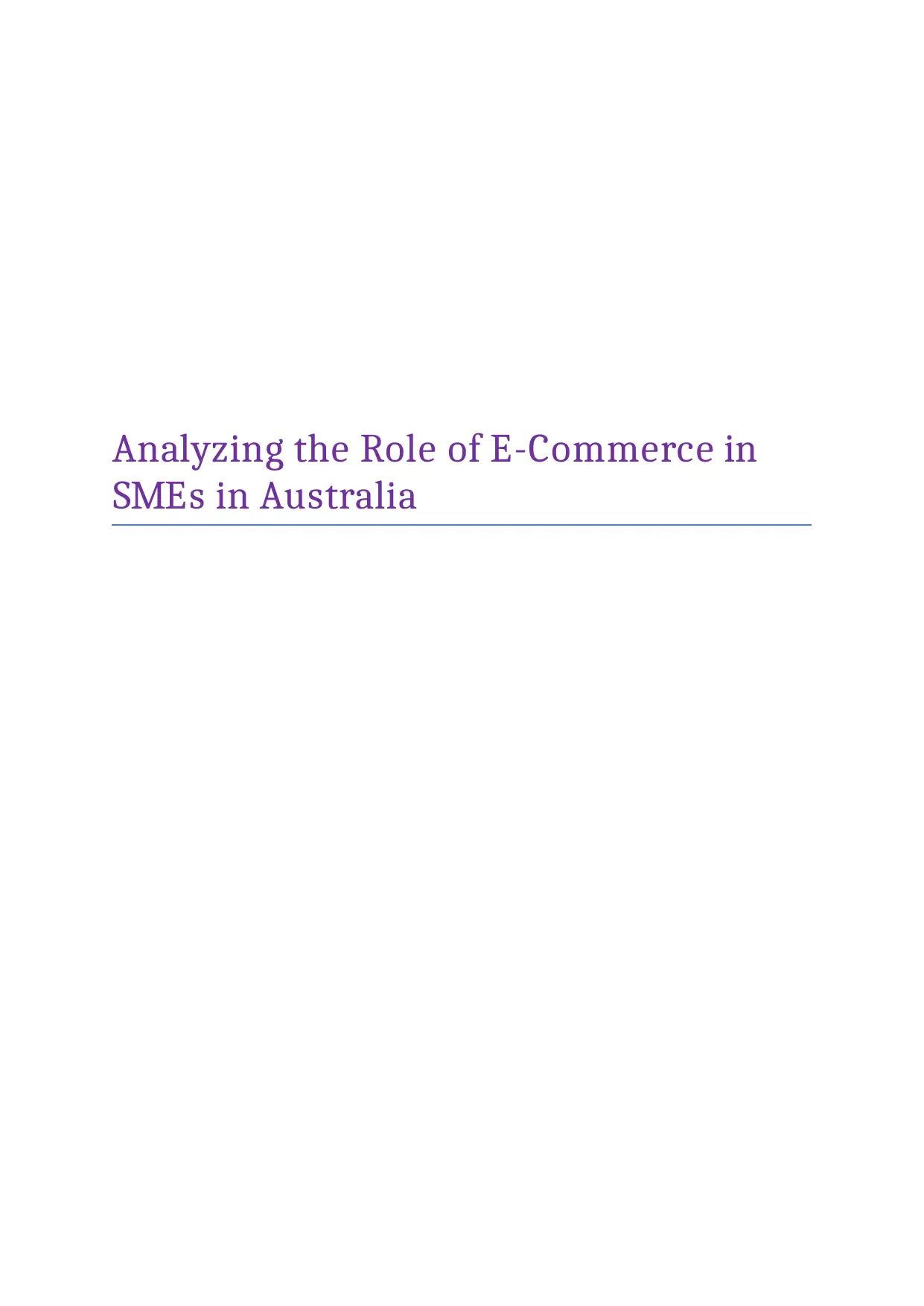
Analyzing the Role of E-Commerce in
SMEs in Australia
SMEs in Australia
Paraphrase This Document
Need a fresh take? Get an instant paraphrase of this document with our AI Paraphraser
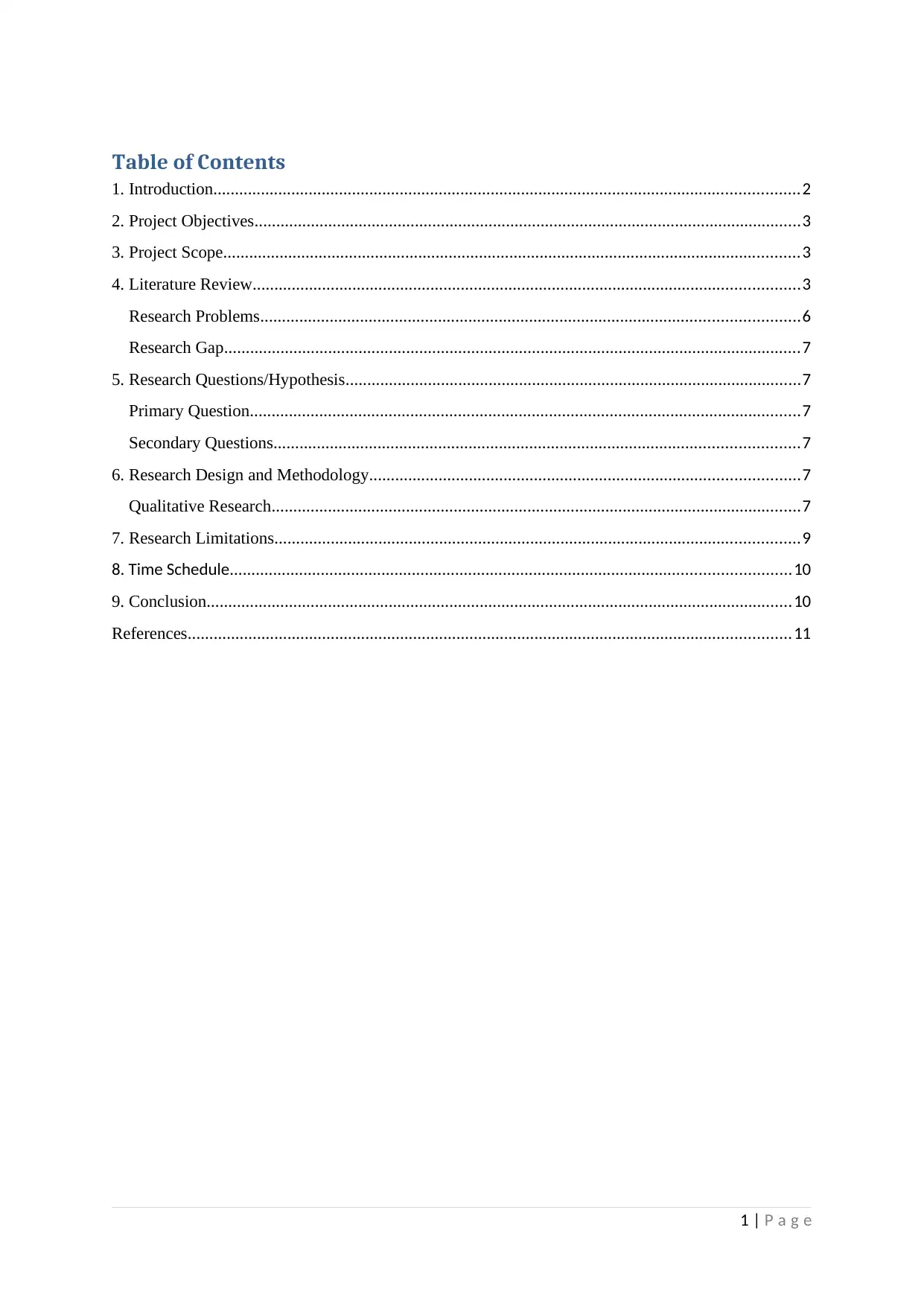
Table of Contents
1. Introduction.......................................................................................................................................2
2. Project Objectives..............................................................................................................................3
3. Project Scope.....................................................................................................................................3
4. Literature Review..............................................................................................................................3
Research Problems............................................................................................................................6
Research Gap.....................................................................................................................................7
5. Research Questions/Hypothesis.........................................................................................................7
Primary Question...............................................................................................................................7
Secondary Questions.........................................................................................................................7
6. Research Design and Methodology...................................................................................................7
Qualitative Research..........................................................................................................................7
7. Research Limitations.........................................................................................................................9
8. Time Schedule.................................................................................................................................10
9. Conclusion.......................................................................................................................................10
References...........................................................................................................................................11
1 | P a g e
1. Introduction.......................................................................................................................................2
2. Project Objectives..............................................................................................................................3
3. Project Scope.....................................................................................................................................3
4. Literature Review..............................................................................................................................3
Research Problems............................................................................................................................6
Research Gap.....................................................................................................................................7
5. Research Questions/Hypothesis.........................................................................................................7
Primary Question...............................................................................................................................7
Secondary Questions.........................................................................................................................7
6. Research Design and Methodology...................................................................................................7
Qualitative Research..........................................................................................................................7
7. Research Limitations.........................................................................................................................9
8. Time Schedule.................................................................................................................................10
9. Conclusion.......................................................................................................................................10
References...........................................................................................................................................11
1 | P a g e
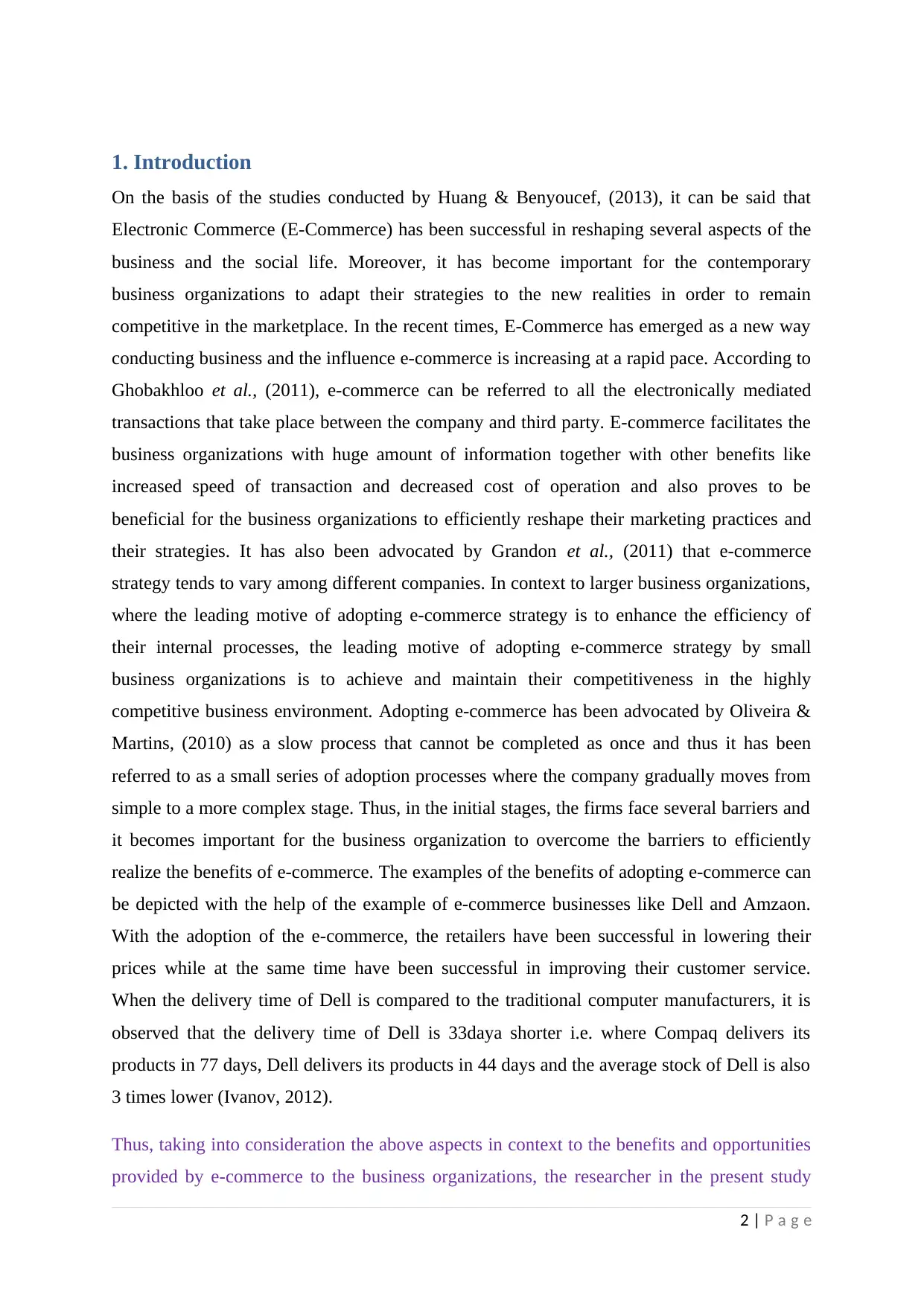
1. Introduction
On the basis of the studies conducted by Huang & Benyoucef, (2013), it can be said that
Electronic Commerce (E-Commerce) has been successful in reshaping several aspects of the
business and the social life. Moreover, it has become important for the contemporary
business organizations to adapt their strategies to the new realities in order to remain
competitive in the marketplace. In the recent times, E-Commerce has emerged as a new way
conducting business and the influence e-commerce is increasing at a rapid pace. According to
Ghobakhloo et al., (2011), e-commerce can be referred to all the electronically mediated
transactions that take place between the company and third party. E-commerce facilitates the
business organizations with huge amount of information together with other benefits like
increased speed of transaction and decreased cost of operation and also proves to be
beneficial for the business organizations to efficiently reshape their marketing practices and
their strategies. It has also been advocated by Grandon et al., (2011) that e-commerce
strategy tends to vary among different companies. In context to larger business organizations,
where the leading motive of adopting e-commerce strategy is to enhance the efficiency of
their internal processes, the leading motive of adopting e-commerce strategy by small
business organizations is to achieve and maintain their competitiveness in the highly
competitive business environment. Adopting e-commerce has been advocated by Oliveira &
Martins, (2010) as a slow process that cannot be completed as once and thus it has been
referred to as a small series of adoption processes where the company gradually moves from
simple to a more complex stage. Thus, in the initial stages, the firms face several barriers and
it becomes important for the business organization to overcome the barriers to efficiently
realize the benefits of e-commerce. The examples of the benefits of adopting e-commerce can
be depicted with the help of the example of e-commerce businesses like Dell and Amzaon.
With the adoption of the e-commerce, the retailers have been successful in lowering their
prices while at the same time have been successful in improving their customer service.
When the delivery time of Dell is compared to the traditional computer manufacturers, it is
observed that the delivery time of Dell is 33daya shorter i.e. where Compaq delivers its
products in 77 days, Dell delivers its products in 44 days and the average stock of Dell is also
3 times lower (Ivanov, 2012).
Thus, taking into consideration the above aspects in context to the benefits and opportunities
provided by e-commerce to the business organizations, the researcher in the present study
2 | P a g e
On the basis of the studies conducted by Huang & Benyoucef, (2013), it can be said that
Electronic Commerce (E-Commerce) has been successful in reshaping several aspects of the
business and the social life. Moreover, it has become important for the contemporary
business organizations to adapt their strategies to the new realities in order to remain
competitive in the marketplace. In the recent times, E-Commerce has emerged as a new way
conducting business and the influence e-commerce is increasing at a rapid pace. According to
Ghobakhloo et al., (2011), e-commerce can be referred to all the electronically mediated
transactions that take place between the company and third party. E-commerce facilitates the
business organizations with huge amount of information together with other benefits like
increased speed of transaction and decreased cost of operation and also proves to be
beneficial for the business organizations to efficiently reshape their marketing practices and
their strategies. It has also been advocated by Grandon et al., (2011) that e-commerce
strategy tends to vary among different companies. In context to larger business organizations,
where the leading motive of adopting e-commerce strategy is to enhance the efficiency of
their internal processes, the leading motive of adopting e-commerce strategy by small
business organizations is to achieve and maintain their competitiveness in the highly
competitive business environment. Adopting e-commerce has been advocated by Oliveira &
Martins, (2010) as a slow process that cannot be completed as once and thus it has been
referred to as a small series of adoption processes where the company gradually moves from
simple to a more complex stage. Thus, in the initial stages, the firms face several barriers and
it becomes important for the business organization to overcome the barriers to efficiently
realize the benefits of e-commerce. The examples of the benefits of adopting e-commerce can
be depicted with the help of the example of e-commerce businesses like Dell and Amzaon.
With the adoption of the e-commerce, the retailers have been successful in lowering their
prices while at the same time have been successful in improving their customer service.
When the delivery time of Dell is compared to the traditional computer manufacturers, it is
observed that the delivery time of Dell is 33daya shorter i.e. where Compaq delivers its
products in 77 days, Dell delivers its products in 44 days and the average stock of Dell is also
3 times lower (Ivanov, 2012).
Thus, taking into consideration the above aspects in context to the benefits and opportunities
provided by e-commerce to the business organizations, the researcher in the present study
2 | P a g e
⊘ This is a preview!⊘
Do you want full access?
Subscribe today to unlock all pages.

Trusted by 1+ million students worldwide
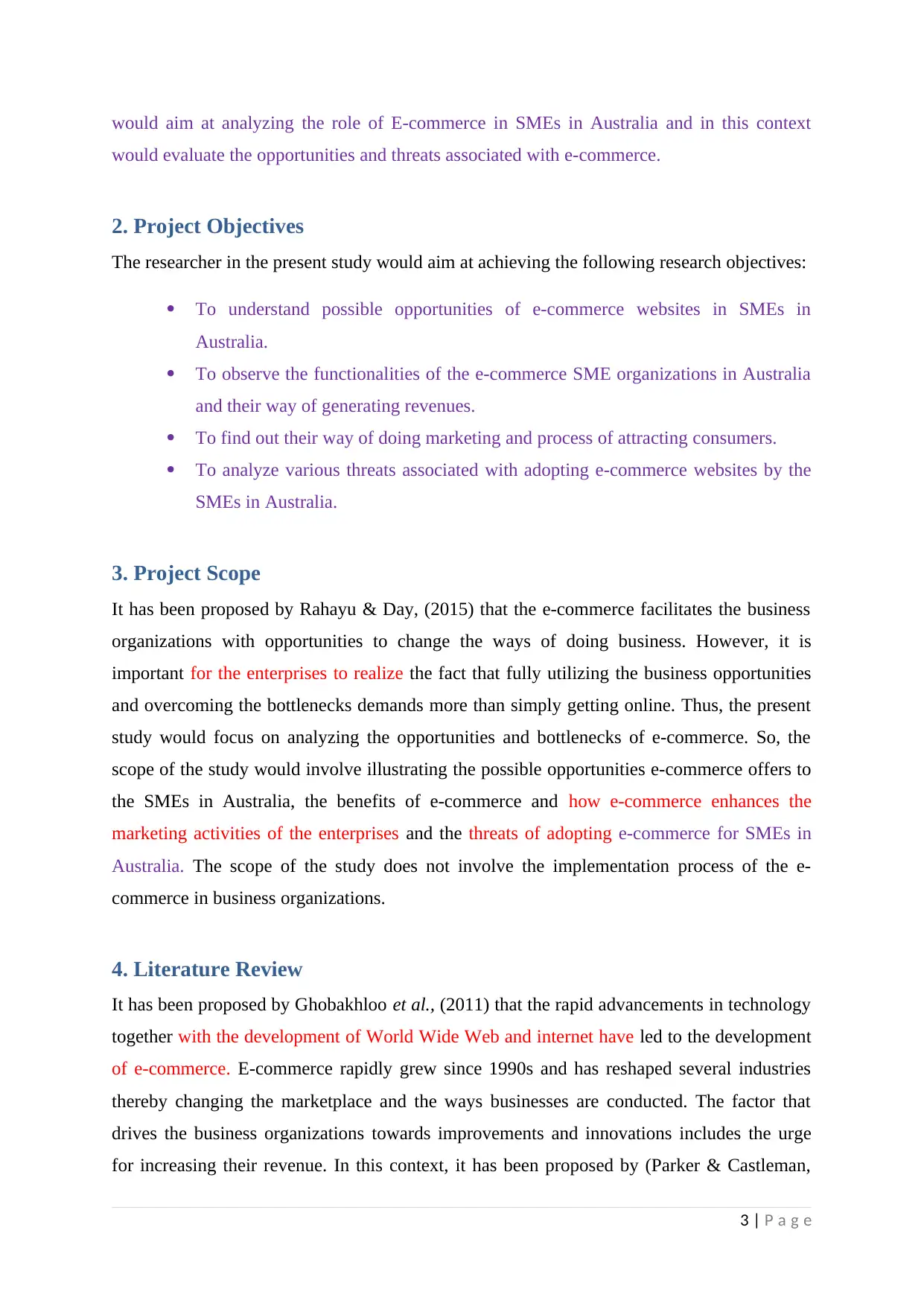
would aim at analyzing the role of E-commerce in SMEs in Australia and in this context
would evaluate the opportunities and threats associated with e-commerce.
2. Project Objectives
The researcher in the present study would aim at achieving the following research objectives:
To understand possible opportunities of e-commerce websites in SMEs in
Australia.
To observe the functionalities of the e-commerce SME organizations in Australia
and their way of generating revenues.
To find out their way of doing marketing and process of attracting consumers.
To analyze various threats associated with adopting e-commerce websites by the
SMEs in Australia.
3. Project Scope
It has been proposed by Rahayu & Day, (2015) that the e-commerce facilitates the business
organizations with opportunities to change the ways of doing business. However, it is
important for the enterprises to realize the fact that fully utilizing the business opportunities
and overcoming the bottlenecks demands more than simply getting online. Thus, the present
study would focus on analyzing the opportunities and bottlenecks of e-commerce. So, the
scope of the study would involve illustrating the possible opportunities e-commerce offers to
the SMEs in Australia, the benefits of e-commerce and how e-commerce enhances the
marketing activities of the enterprises and the threats of adopting e-commerce for SMEs in
Australia. The scope of the study does not involve the implementation process of the e-
commerce in business organizations.
4. Literature Review
It has been proposed by Ghobakhloo et al., (2011) that the rapid advancements in technology
together with the development of World Wide Web and internet have led to the development
of e-commerce. E-commerce rapidly grew since 1990s and has reshaped several industries
thereby changing the marketplace and the ways businesses are conducted. The factor that
drives the business organizations towards improvements and innovations includes the urge
for increasing their revenue. In this context, it has been proposed by (Parker & Castleman,
3 | P a g e
would evaluate the opportunities and threats associated with e-commerce.
2. Project Objectives
The researcher in the present study would aim at achieving the following research objectives:
To understand possible opportunities of e-commerce websites in SMEs in
Australia.
To observe the functionalities of the e-commerce SME organizations in Australia
and their way of generating revenues.
To find out their way of doing marketing and process of attracting consumers.
To analyze various threats associated with adopting e-commerce websites by the
SMEs in Australia.
3. Project Scope
It has been proposed by Rahayu & Day, (2015) that the e-commerce facilitates the business
organizations with opportunities to change the ways of doing business. However, it is
important for the enterprises to realize the fact that fully utilizing the business opportunities
and overcoming the bottlenecks demands more than simply getting online. Thus, the present
study would focus on analyzing the opportunities and bottlenecks of e-commerce. So, the
scope of the study would involve illustrating the possible opportunities e-commerce offers to
the SMEs in Australia, the benefits of e-commerce and how e-commerce enhances the
marketing activities of the enterprises and the threats of adopting e-commerce for SMEs in
Australia. The scope of the study does not involve the implementation process of the e-
commerce in business organizations.
4. Literature Review
It has been proposed by Ghobakhloo et al., (2011) that the rapid advancements in technology
together with the development of World Wide Web and internet have led to the development
of e-commerce. E-commerce rapidly grew since 1990s and has reshaped several industries
thereby changing the marketplace and the ways businesses are conducted. The factor that
drives the business organizations towards improvements and innovations includes the urge
for increasing their revenue. In this context, it has been proposed by (Parker & Castleman,
3 | P a g e
Paraphrase This Document
Need a fresh take? Get an instant paraphrase of this document with our AI Paraphraser
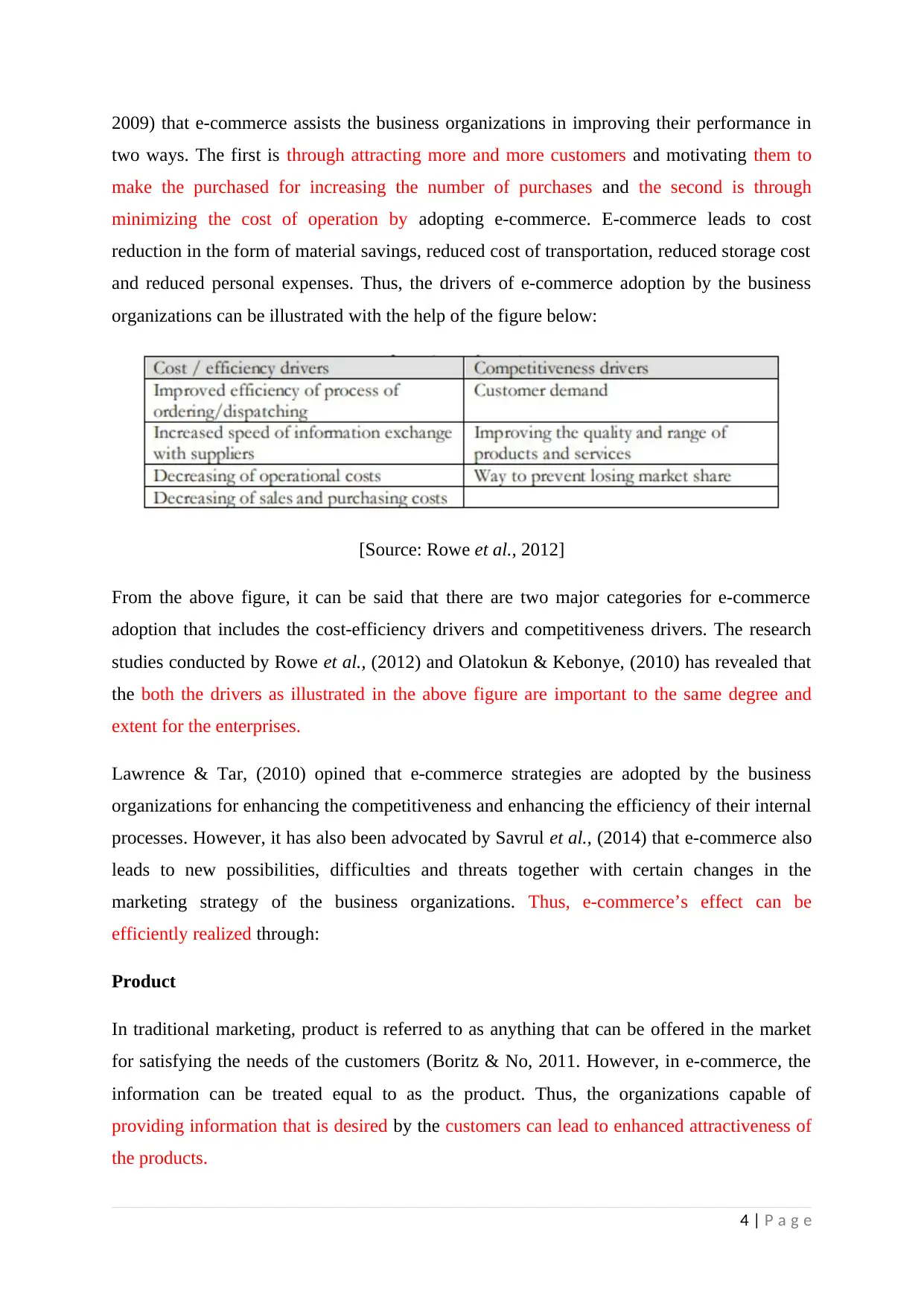
2009) that e-commerce assists the business organizations in improving their performance in
two ways. The first is through attracting more and more customers and motivating them to
make the purchased for increasing the number of purchases and the second is through
minimizing the cost of operation by adopting e-commerce. E-commerce leads to cost
reduction in the form of material savings, reduced cost of transportation, reduced storage cost
and reduced personal expenses. Thus, the drivers of e-commerce adoption by the business
organizations can be illustrated with the help of the figure below:
[Source: Rowe et al., 2012]
From the above figure, it can be said that there are two major categories for e-commerce
adoption that includes the cost-efficiency drivers and competitiveness drivers. The research
studies conducted by Rowe et al., (2012) and Olatokun & Kebonye, (2010) has revealed that
the both the drivers as illustrated in the above figure are important to the same degree and
extent for the enterprises.
Lawrence & Tar, (2010) opined that e-commerce strategies are adopted by the business
organizations for enhancing the competitiveness and enhancing the efficiency of their internal
processes. However, it has also been advocated by Savrul et al., (2014) that e-commerce also
leads to new possibilities, difficulties and threats together with certain changes in the
marketing strategy of the business organizations. Thus, e-commerce’s effect can be
efficiently realized through:
Product
In traditional marketing, product is referred to as anything that can be offered in the market
for satisfying the needs of the customers (Boritz & No, 2011. However, in e-commerce, the
information can be treated equal to as the product. Thus, the organizations capable of
providing information that is desired by the customers can lead to enhanced attractiveness of
the products.
4 | P a g e
two ways. The first is through attracting more and more customers and motivating them to
make the purchased for increasing the number of purchases and the second is through
minimizing the cost of operation by adopting e-commerce. E-commerce leads to cost
reduction in the form of material savings, reduced cost of transportation, reduced storage cost
and reduced personal expenses. Thus, the drivers of e-commerce adoption by the business
organizations can be illustrated with the help of the figure below:
[Source: Rowe et al., 2012]
From the above figure, it can be said that there are two major categories for e-commerce
adoption that includes the cost-efficiency drivers and competitiveness drivers. The research
studies conducted by Rowe et al., (2012) and Olatokun & Kebonye, (2010) has revealed that
the both the drivers as illustrated in the above figure are important to the same degree and
extent for the enterprises.
Lawrence & Tar, (2010) opined that e-commerce strategies are adopted by the business
organizations for enhancing the competitiveness and enhancing the efficiency of their internal
processes. However, it has also been advocated by Savrul et al., (2014) that e-commerce also
leads to new possibilities, difficulties and threats together with certain changes in the
marketing strategy of the business organizations. Thus, e-commerce’s effect can be
efficiently realized through:
Product
In traditional marketing, product is referred to as anything that can be offered in the market
for satisfying the needs of the customers (Boritz & No, 2011. However, in e-commerce, the
information can be treated equal to as the product. Thus, the organizations capable of
providing information that is desired by the customers can lead to enhanced attractiveness of
the products.
4 | P a g e
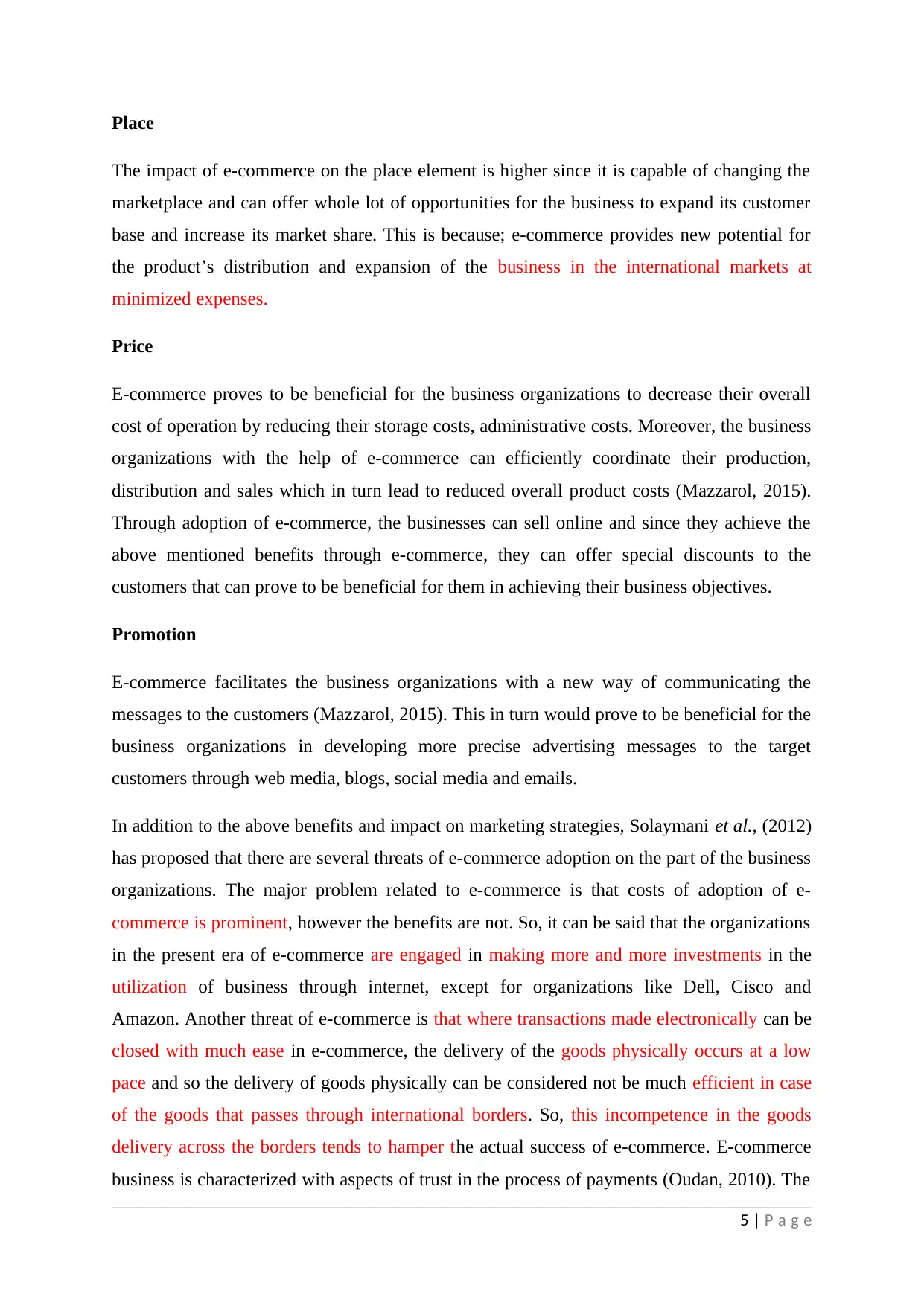
Place
The impact of e-commerce on the place element is higher since it is capable of changing the
marketplace and can offer whole lot of opportunities for the business to expand its customer
base and increase its market share. This is because; e-commerce provides new potential for
the product’s distribution and expansion of the business in the international markets at
minimized expenses.
Price
E-commerce proves to be beneficial for the business organizations to decrease their overall
cost of operation by reducing their storage costs, administrative costs. Moreover, the business
organizations with the help of e-commerce can efficiently coordinate their production,
distribution and sales which in turn lead to reduced overall product costs (Mazzarol, 2015).
Through adoption of e-commerce, the businesses can sell online and since they achieve the
above mentioned benefits through e-commerce, they can offer special discounts to the
customers that can prove to be beneficial for them in achieving their business objectives.
Promotion
E-commerce facilitates the business organizations with a new way of communicating the
messages to the customers (Mazzarol, 2015). This in turn would prove to be beneficial for the
business organizations in developing more precise advertising messages to the target
customers through web media, blogs, social media and emails.
In addition to the above benefits and impact on marketing strategies, Solaymani et al., (2012)
has proposed that there are several threats of e-commerce adoption on the part of the business
organizations. The major problem related to e-commerce is that costs of adoption of e-
commerce is prominent, however the benefits are not. So, it can be said that the organizations
in the present era of e-commerce are engaged in making more and more investments in the
utilization of business through internet, except for organizations like Dell, Cisco and
Amazon. Another threat of e-commerce is that where transactions made electronically can be
closed with much ease in e-commerce, the delivery of the goods physically occurs at a low
pace and so the delivery of goods physically can be considered not be much efficient in case
of the goods that passes through international borders. So, this incompetence in the goods
delivery across the borders tends to hamper the actual success of e-commerce. E-commerce
business is characterized with aspects of trust in the process of payments (Oudan, 2010). The
5 | P a g e
The impact of e-commerce on the place element is higher since it is capable of changing the
marketplace and can offer whole lot of opportunities for the business to expand its customer
base and increase its market share. This is because; e-commerce provides new potential for
the product’s distribution and expansion of the business in the international markets at
minimized expenses.
Price
E-commerce proves to be beneficial for the business organizations to decrease their overall
cost of operation by reducing their storage costs, administrative costs. Moreover, the business
organizations with the help of e-commerce can efficiently coordinate their production,
distribution and sales which in turn lead to reduced overall product costs (Mazzarol, 2015).
Through adoption of e-commerce, the businesses can sell online and since they achieve the
above mentioned benefits through e-commerce, they can offer special discounts to the
customers that can prove to be beneficial for them in achieving their business objectives.
Promotion
E-commerce facilitates the business organizations with a new way of communicating the
messages to the customers (Mazzarol, 2015). This in turn would prove to be beneficial for the
business organizations in developing more precise advertising messages to the target
customers through web media, blogs, social media and emails.
In addition to the above benefits and impact on marketing strategies, Solaymani et al., (2012)
has proposed that there are several threats of e-commerce adoption on the part of the business
organizations. The major problem related to e-commerce is that costs of adoption of e-
commerce is prominent, however the benefits are not. So, it can be said that the organizations
in the present era of e-commerce are engaged in making more and more investments in the
utilization of business through internet, except for organizations like Dell, Cisco and
Amazon. Another threat of e-commerce is that where transactions made electronically can be
closed with much ease in e-commerce, the delivery of the goods physically occurs at a low
pace and so the delivery of goods physically can be considered not be much efficient in case
of the goods that passes through international borders. So, this incompetence in the goods
delivery across the borders tends to hamper the actual success of e-commerce. E-commerce
business is characterized with aspects of trust in the process of payments (Oudan, 2010). The
5 | P a g e
⊘ This is a preview!⊘
Do you want full access?
Subscribe today to unlock all pages.

Trusted by 1+ million students worldwide
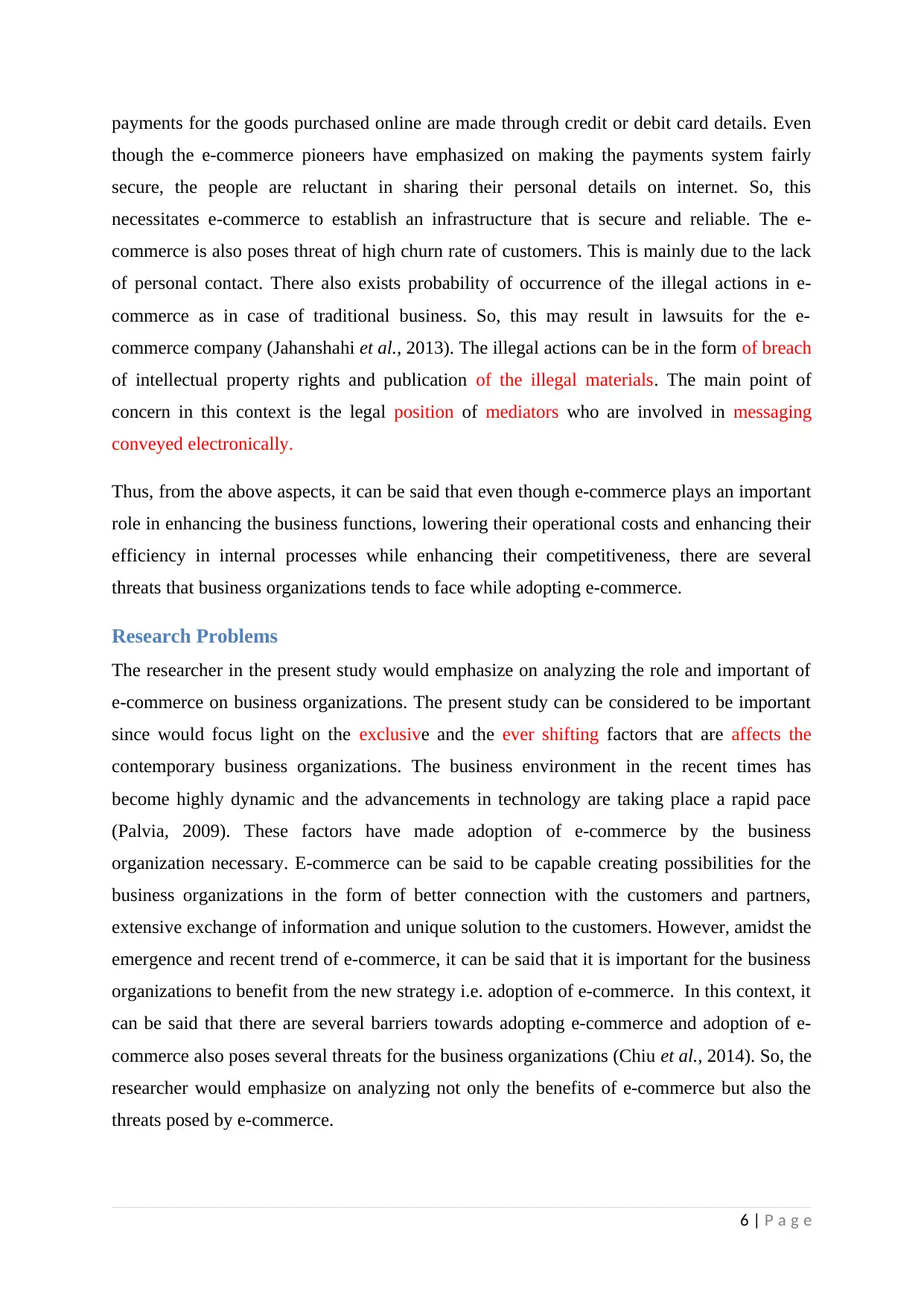
payments for the goods purchased online are made through credit or debit card details. Even
though the e-commerce pioneers have emphasized on making the payments system fairly
secure, the people are reluctant in sharing their personal details on internet. So, this
necessitates e-commerce to establish an infrastructure that is secure and reliable. The e-
commerce is also poses threat of high churn rate of customers. This is mainly due to the lack
of personal contact. There also exists probability of occurrence of the illegal actions in e-
commerce as in case of traditional business. So, this may result in lawsuits for the e-
commerce company (Jahanshahi et al., 2013). The illegal actions can be in the form of breach
of intellectual property rights and publication of the illegal materials. The main point of
concern in this context is the legal position of mediators who are involved in messaging
conveyed electronically.
Thus, from the above aspects, it can be said that even though e-commerce plays an important
role in enhancing the business functions, lowering their operational costs and enhancing their
efficiency in internal processes while enhancing their competitiveness, there are several
threats that business organizations tends to face while adopting e-commerce.
Research Problems
The researcher in the present study would emphasize on analyzing the role and important of
e-commerce on business organizations. The present study can be considered to be important
since would focus light on the exclusive and the ever shifting factors that are affects the
contemporary business organizations. The business environment in the recent times has
become highly dynamic and the advancements in technology are taking place a rapid pace
(Palvia, 2009). These factors have made adoption of e-commerce by the business
organization necessary. E-commerce can be said to be capable creating possibilities for the
business organizations in the form of better connection with the customers and partners,
extensive exchange of information and unique solution to the customers. However, amidst the
emergence and recent trend of e-commerce, it can be said that it is important for the business
organizations to benefit from the new strategy i.e. adoption of e-commerce. In this context, it
can be said that there are several barriers towards adopting e-commerce and adoption of e-
commerce also poses several threats for the business organizations (Chiu et al., 2014). So, the
researcher would emphasize on analyzing not only the benefits of e-commerce but also the
threats posed by e-commerce.
6 | P a g e
though the e-commerce pioneers have emphasized on making the payments system fairly
secure, the people are reluctant in sharing their personal details on internet. So, this
necessitates e-commerce to establish an infrastructure that is secure and reliable. The e-
commerce is also poses threat of high churn rate of customers. This is mainly due to the lack
of personal contact. There also exists probability of occurrence of the illegal actions in e-
commerce as in case of traditional business. So, this may result in lawsuits for the e-
commerce company (Jahanshahi et al., 2013). The illegal actions can be in the form of breach
of intellectual property rights and publication of the illegal materials. The main point of
concern in this context is the legal position of mediators who are involved in messaging
conveyed electronically.
Thus, from the above aspects, it can be said that even though e-commerce plays an important
role in enhancing the business functions, lowering their operational costs and enhancing their
efficiency in internal processes while enhancing their competitiveness, there are several
threats that business organizations tends to face while adopting e-commerce.
Research Problems
The researcher in the present study would emphasize on analyzing the role and important of
e-commerce on business organizations. The present study can be considered to be important
since would focus light on the exclusive and the ever shifting factors that are affects the
contemporary business organizations. The business environment in the recent times has
become highly dynamic and the advancements in technology are taking place a rapid pace
(Palvia, 2009). These factors have made adoption of e-commerce by the business
organization necessary. E-commerce can be said to be capable creating possibilities for the
business organizations in the form of better connection with the customers and partners,
extensive exchange of information and unique solution to the customers. However, amidst the
emergence and recent trend of e-commerce, it can be said that it is important for the business
organizations to benefit from the new strategy i.e. adoption of e-commerce. In this context, it
can be said that there are several barriers towards adopting e-commerce and adoption of e-
commerce also poses several threats for the business organizations (Chiu et al., 2014). So, the
researcher would emphasize on analyzing not only the benefits of e-commerce but also the
threats posed by e-commerce.
6 | P a g e
Paraphrase This Document
Need a fresh take? Get an instant paraphrase of this document with our AI Paraphraser
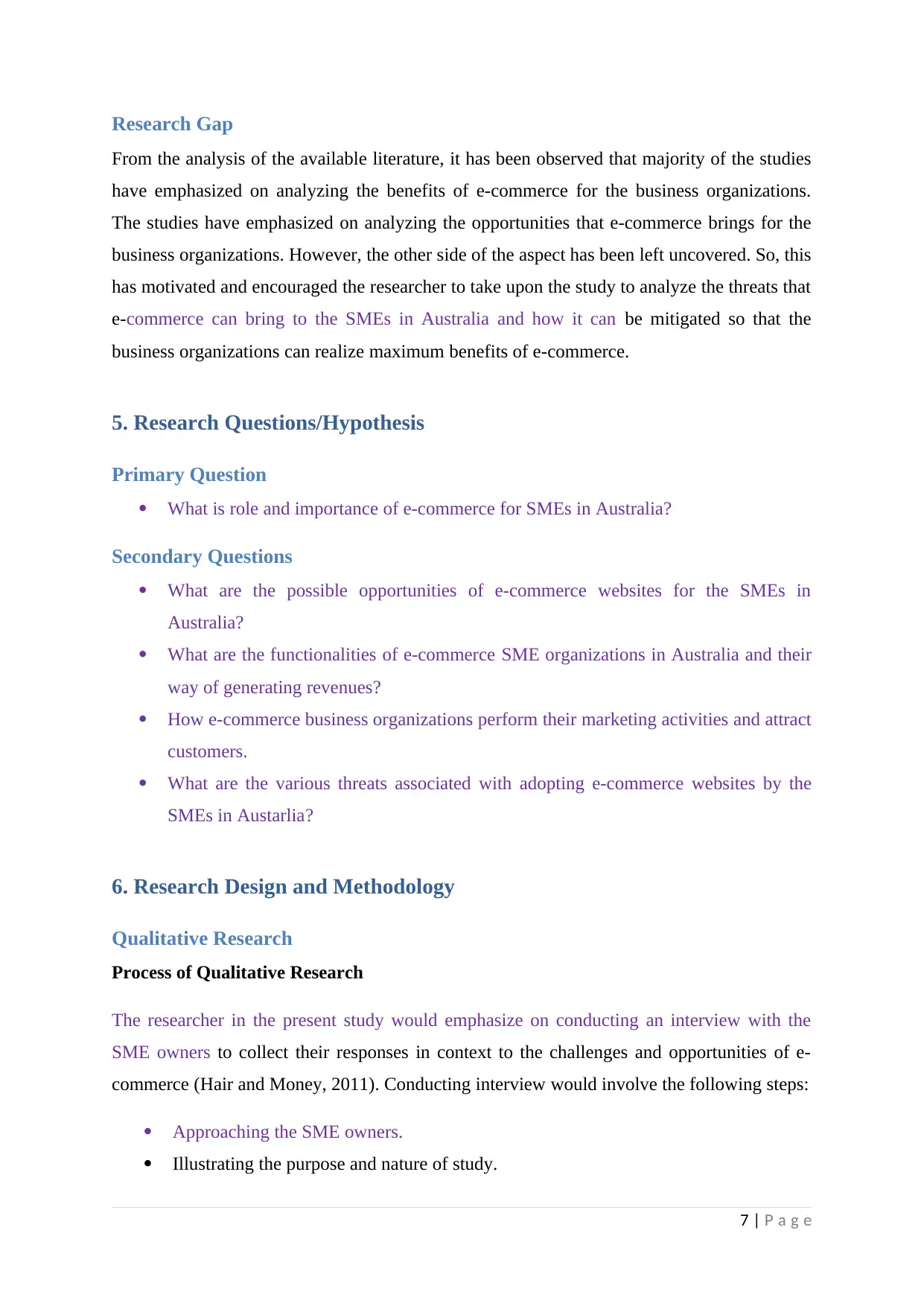
Research Gap
From the analysis of the available literature, it has been observed that majority of the studies
have emphasized on analyzing the benefits of e-commerce for the business organizations.
The studies have emphasized on analyzing the opportunities that e-commerce brings for the
business organizations. However, the other side of the aspect has been left uncovered. So, this
has motivated and encouraged the researcher to take upon the study to analyze the threats that
e-commerce can bring to the SMEs in Australia and how it can be mitigated so that the
business organizations can realize maximum benefits of e-commerce.
5. Research Questions/Hypothesis
Primary Question
What is role and importance of e-commerce for SMEs in Australia?
Secondary Questions
What are the possible opportunities of e-commerce websites for the SMEs in
Australia?
What are the functionalities of e-commerce SME organizations in Australia and their
way of generating revenues?
How e-commerce business organizations perform their marketing activities and attract
customers.
What are the various threats associated with adopting e-commerce websites by the
SMEs in Austarlia?
6. Research Design and Methodology
Qualitative Research
Process of Qualitative Research
The researcher in the present study would emphasize on conducting an interview with the
SME owners to collect their responses in context to the challenges and opportunities of e-
commerce (Hair and Money, 2011). Conducting interview would involve the following steps:
Approaching the SME owners.
Illustrating the purpose and nature of study.
7 | P a g e
From the analysis of the available literature, it has been observed that majority of the studies
have emphasized on analyzing the benefits of e-commerce for the business organizations.
The studies have emphasized on analyzing the opportunities that e-commerce brings for the
business organizations. However, the other side of the aspect has been left uncovered. So, this
has motivated and encouraged the researcher to take upon the study to analyze the threats that
e-commerce can bring to the SMEs in Australia and how it can be mitigated so that the
business organizations can realize maximum benefits of e-commerce.
5. Research Questions/Hypothesis
Primary Question
What is role and importance of e-commerce for SMEs in Australia?
Secondary Questions
What are the possible opportunities of e-commerce websites for the SMEs in
Australia?
What are the functionalities of e-commerce SME organizations in Australia and their
way of generating revenues?
How e-commerce business organizations perform their marketing activities and attract
customers.
What are the various threats associated with adopting e-commerce websites by the
SMEs in Austarlia?
6. Research Design and Methodology
Qualitative Research
Process of Qualitative Research
The researcher in the present study would emphasize on conducting an interview with the
SME owners to collect their responses in context to the challenges and opportunities of e-
commerce (Hair and Money, 2011). Conducting interview would involve the following steps:
Approaching the SME owners.
Illustrating the purpose and nature of study.
7 | P a g e
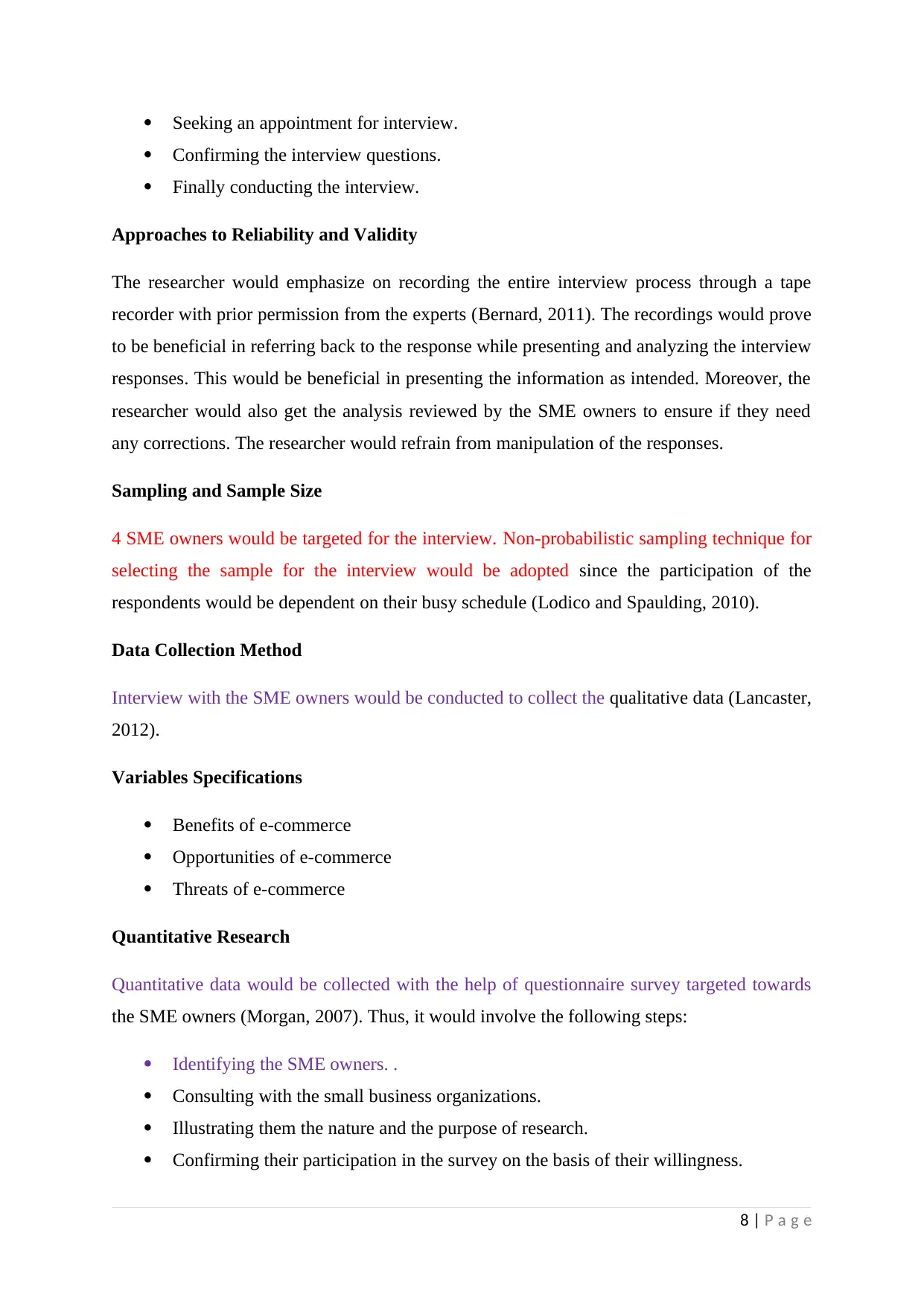
Seeking an appointment for interview.
Confirming the interview questions.
Finally conducting the interview.
Approaches to Reliability and Validity
The researcher would emphasize on recording the entire interview process through a tape
recorder with prior permission from the experts (Bernard, 2011). The recordings would prove
to be beneficial in referring back to the response while presenting and analyzing the interview
responses. This would be beneficial in presenting the information as intended. Moreover, the
researcher would also get the analysis reviewed by the SME owners to ensure if they need
any corrections. The researcher would refrain from manipulation of the responses.
Sampling and Sample Size
4 SME owners would be targeted for the interview. Non-probabilistic sampling technique for
selecting the sample for the interview would be adopted since the participation of the
respondents would be dependent on their busy schedule (Lodico and Spaulding, 2010).
Data Collection Method
Interview with the SME owners would be conducted to collect the qualitative data (Lancaster,
2012).
Variables Specifications
Benefits of e-commerce
Opportunities of e-commerce
Threats of e-commerce
Quantitative Research
Quantitative data would be collected with the help of questionnaire survey targeted towards
the SME owners (Morgan, 2007). Thus, it would involve the following steps:
Identifying the SME owners. .
Consulting with the small business organizations.
Illustrating them the nature and the purpose of research.
Confirming their participation in the survey on the basis of their willingness.
8 | P a g e
Confirming the interview questions.
Finally conducting the interview.
Approaches to Reliability and Validity
The researcher would emphasize on recording the entire interview process through a tape
recorder with prior permission from the experts (Bernard, 2011). The recordings would prove
to be beneficial in referring back to the response while presenting and analyzing the interview
responses. This would be beneficial in presenting the information as intended. Moreover, the
researcher would also get the analysis reviewed by the SME owners to ensure if they need
any corrections. The researcher would refrain from manipulation of the responses.
Sampling and Sample Size
4 SME owners would be targeted for the interview. Non-probabilistic sampling technique for
selecting the sample for the interview would be adopted since the participation of the
respondents would be dependent on their busy schedule (Lodico and Spaulding, 2010).
Data Collection Method
Interview with the SME owners would be conducted to collect the qualitative data (Lancaster,
2012).
Variables Specifications
Benefits of e-commerce
Opportunities of e-commerce
Threats of e-commerce
Quantitative Research
Quantitative data would be collected with the help of questionnaire survey targeted towards
the SME owners (Morgan, 2007). Thus, it would involve the following steps:
Identifying the SME owners. .
Consulting with the small business organizations.
Illustrating them the nature and the purpose of research.
Confirming their participation in the survey on the basis of their willingness.
8 | P a g e
⊘ This is a preview!⊘
Do you want full access?
Subscribe today to unlock all pages.

Trusted by 1+ million students worldwide
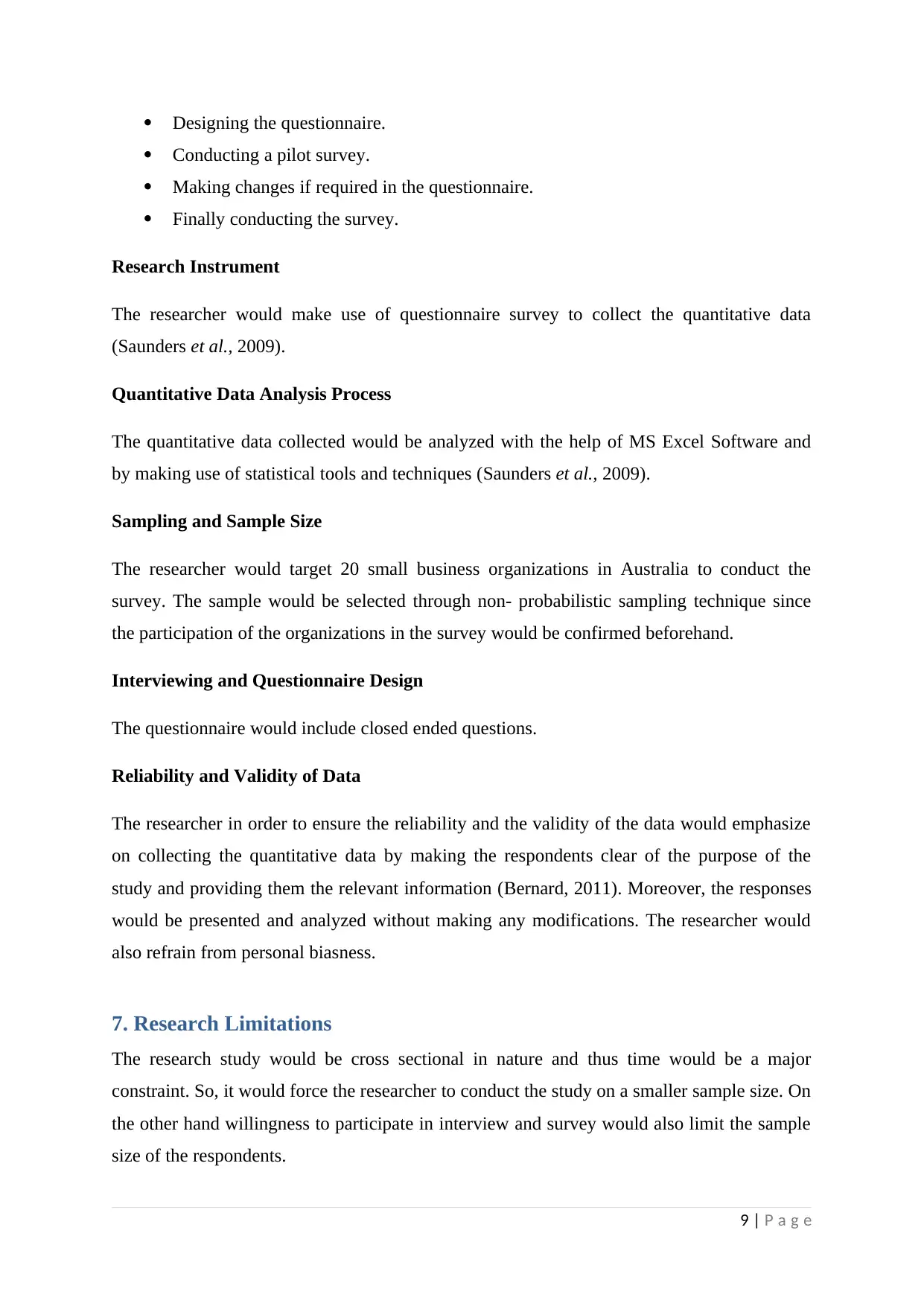
Designing the questionnaire.
Conducting a pilot survey.
Making changes if required in the questionnaire.
Finally conducting the survey.
Research Instrument
The researcher would make use of questionnaire survey to collect the quantitative data
(Saunders et al., 2009).
Quantitative Data Analysis Process
The quantitative data collected would be analyzed with the help of MS Excel Software and
by making use of statistical tools and techniques (Saunders et al., 2009).
Sampling and Sample Size
The researcher would target 20 small business organizations in Australia to conduct the
survey. The sample would be selected through non- probabilistic sampling technique since
the participation of the organizations in the survey would be confirmed beforehand.
Interviewing and Questionnaire Design
The questionnaire would include closed ended questions.
Reliability and Validity of Data
The researcher in order to ensure the reliability and the validity of the data would emphasize
on collecting the quantitative data by making the respondents clear of the purpose of the
study and providing them the relevant information (Bernard, 2011). Moreover, the responses
would be presented and analyzed without making any modifications. The researcher would
also refrain from personal biasness.
7. Research Limitations
The research study would be cross sectional in nature and thus time would be a major
constraint. So, it would force the researcher to conduct the study on a smaller sample size. On
the other hand willingness to participate in interview and survey would also limit the sample
size of the respondents.
9 | P a g e
Conducting a pilot survey.
Making changes if required in the questionnaire.
Finally conducting the survey.
Research Instrument
The researcher would make use of questionnaire survey to collect the quantitative data
(Saunders et al., 2009).
Quantitative Data Analysis Process
The quantitative data collected would be analyzed with the help of MS Excel Software and
by making use of statistical tools and techniques (Saunders et al., 2009).
Sampling and Sample Size
The researcher would target 20 small business organizations in Australia to conduct the
survey. The sample would be selected through non- probabilistic sampling technique since
the participation of the organizations in the survey would be confirmed beforehand.
Interviewing and Questionnaire Design
The questionnaire would include closed ended questions.
Reliability and Validity of Data
The researcher in order to ensure the reliability and the validity of the data would emphasize
on collecting the quantitative data by making the respondents clear of the purpose of the
study and providing them the relevant information (Bernard, 2011). Moreover, the responses
would be presented and analyzed without making any modifications. The researcher would
also refrain from personal biasness.
7. Research Limitations
The research study would be cross sectional in nature and thus time would be a major
constraint. So, it would force the researcher to conduct the study on a smaller sample size. On
the other hand willingness to participate in interview and survey would also limit the sample
size of the respondents.
9 | P a g e
Paraphrase This Document
Need a fresh take? Get an instant paraphrase of this document with our AI Paraphraser
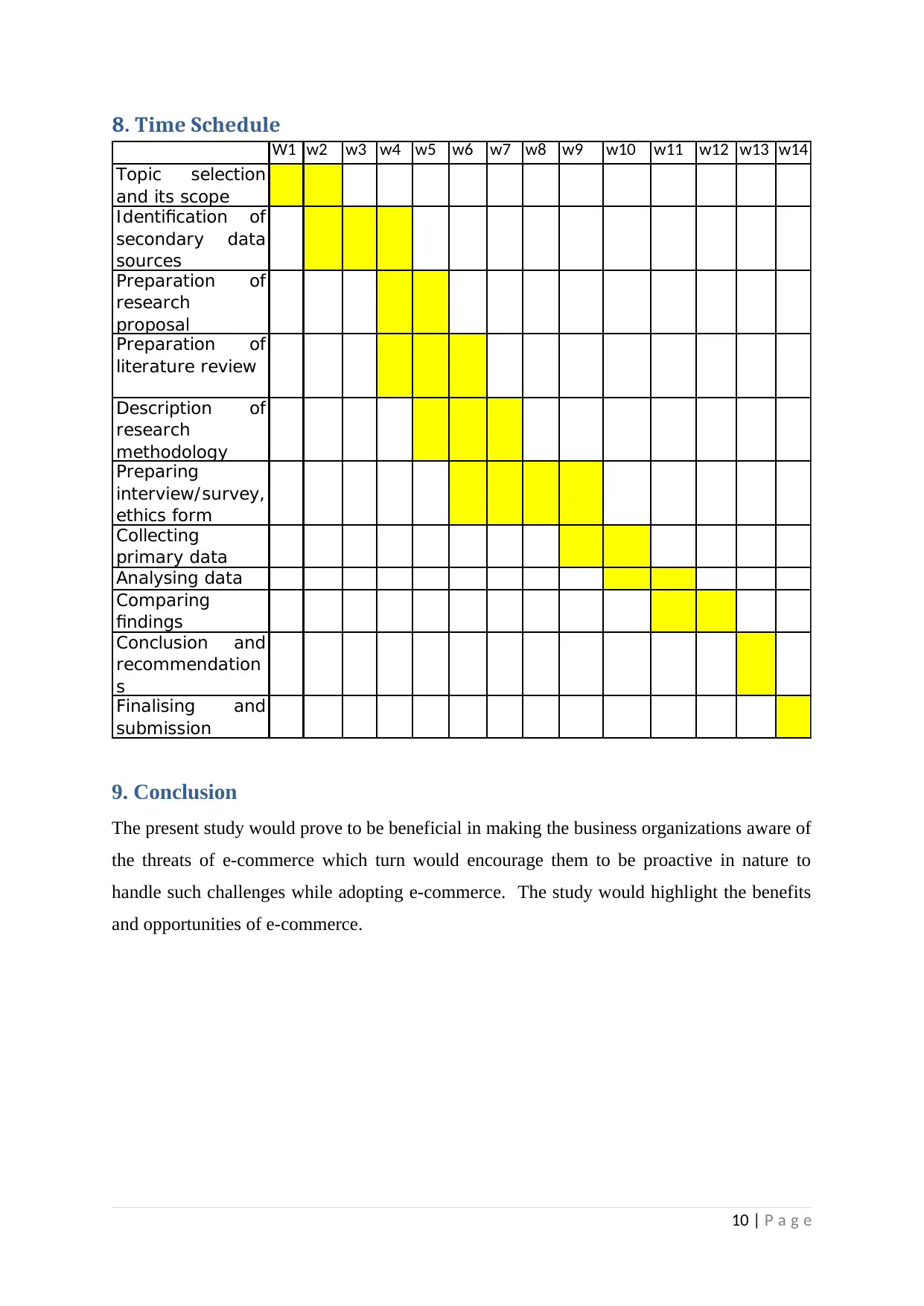
8. Time Schedule
W1 w2 w3 w4 w5 w6 w7 w8 w9 w10 w11 w12 w13 w14
Topic selection
and its scope
Identification of
secondary data
sources
Preparation of
research
proposal
Preparation of
literature review
Description of
research
methodology
Preparing
interview/ survey,
ethics form
Collecting
primary data
Analysing data
Comparing
findings
Conclusion and
recommendation
s
Finalising and
submission
9. Conclusion
The present study would prove to be beneficial in making the business organizations aware of
the threats of e-commerce which turn would encourage them to be proactive in nature to
handle such challenges while adopting e-commerce. The study would highlight the benefits
and opportunities of e-commerce.
10 | P a g e
W1 w2 w3 w4 w5 w6 w7 w8 w9 w10 w11 w12 w13 w14
Topic selection
and its scope
Identification of
secondary data
sources
Preparation of
research
proposal
Preparation of
literature review
Description of
research
methodology
Preparing
interview/ survey,
ethics form
Collecting
primary data
Analysing data
Comparing
findings
Conclusion and
recommendation
s
Finalising and
submission
9. Conclusion
The present study would prove to be beneficial in making the business organizations aware of
the threats of e-commerce which turn would encourage them to be proactive in nature to
handle such challenges while adopting e-commerce. The study would highlight the benefits
and opportunities of e-commerce.
10 | P a g e
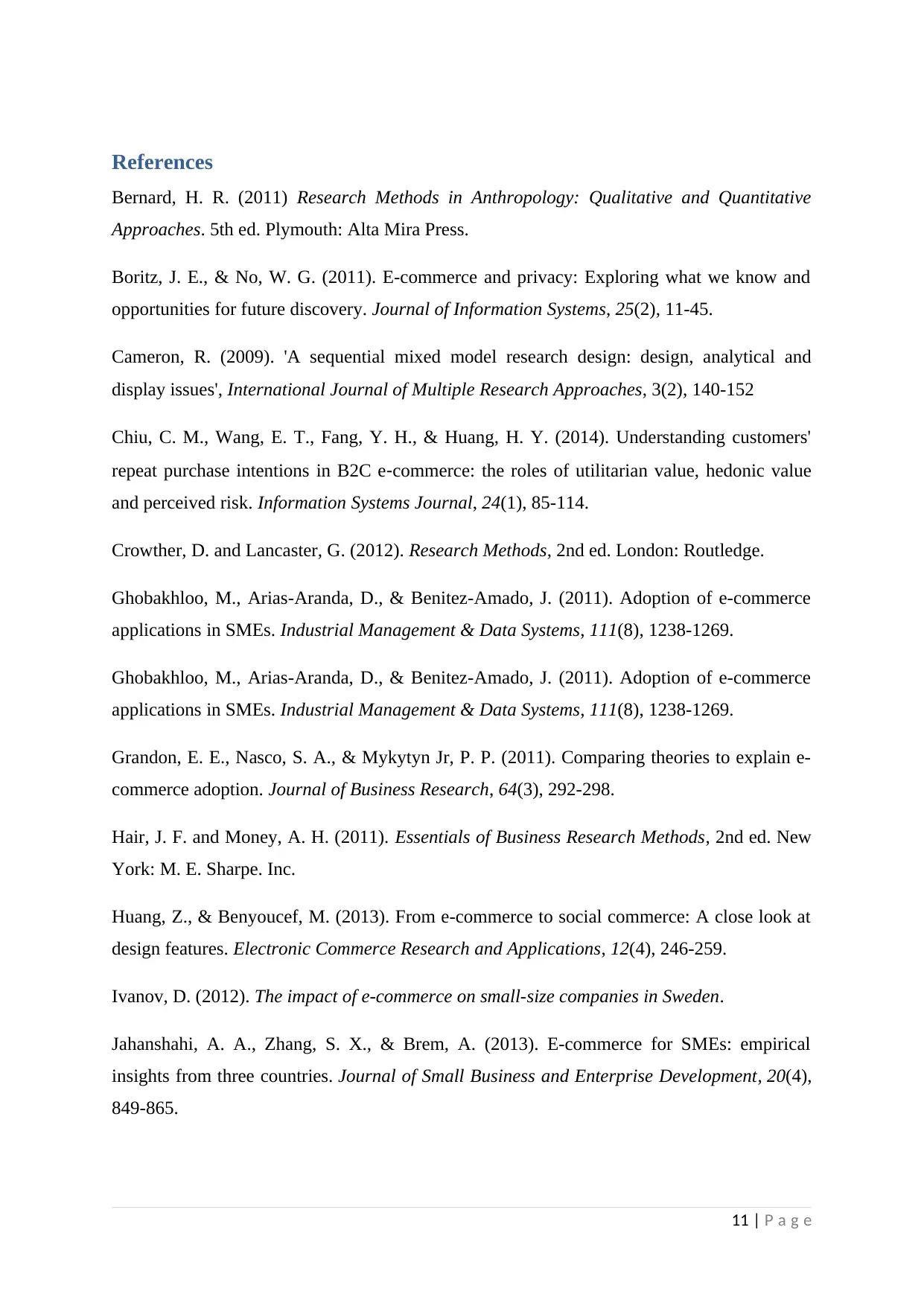
References
Bernard, H. R. (2011) Research Methods in Anthropology: Qualitative and Quantitative
Approaches. 5th ed. Plymouth: Alta Mira Press.
Boritz, J. E., & No, W. G. (2011). E-commerce and privacy: Exploring what we know and
opportunities for future discovery. Journal of Information Systems, 25(2), 11-45.
Cameron, R. (2009). 'A sequential mixed model research design: design, analytical and
display issues', International Journal of Multiple Research Approaches, 3(2), 140-152
Chiu, C. M., Wang, E. T., Fang, Y. H., & Huang, H. Y. (2014). Understanding customers'
repeat purchase intentions in B2C e‐commerce: the roles of utilitarian value, hedonic value
and perceived risk. Information Systems Journal, 24(1), 85-114.
Crowther, D. and Lancaster, G. (2012). Research Methods, 2nd ed. London: Routledge.
Ghobakhloo, M., Arias-Aranda, D., & Benitez-Amado, J. (2011). Adoption of e-commerce
applications in SMEs. Industrial Management & Data Systems, 111(8), 1238-1269.
Ghobakhloo, M., Arias-Aranda, D., & Benitez-Amado, J. (2011). Adoption of e-commerce
applications in SMEs. Industrial Management & Data Systems, 111(8), 1238-1269.
Grandon, E. E., Nasco, S. A., & Mykytyn Jr, P. P. (2011). Comparing theories to explain e-
commerce adoption. Journal of Business Research, 64(3), 292-298.
Hair, J. F. and Money, A. H. (2011). Essentials of Business Research Methods, 2nd ed. New
York: M. E. Sharpe. Inc.
Huang, Z., & Benyoucef, M. (2013). From e-commerce to social commerce: A close look at
design features. Electronic Commerce Research and Applications, 12(4), 246-259.
Ivanov, D. (2012). The impact of e-commerce on small-size companies in Sweden.
Jahanshahi, A. A., Zhang, S. X., & Brem, A. (2013). E-commerce for SMEs: empirical
insights from three countries. Journal of Small Business and Enterprise Development, 20(4),
849-865.
11 | P a g e
Bernard, H. R. (2011) Research Methods in Anthropology: Qualitative and Quantitative
Approaches. 5th ed. Plymouth: Alta Mira Press.
Boritz, J. E., & No, W. G. (2011). E-commerce and privacy: Exploring what we know and
opportunities for future discovery. Journal of Information Systems, 25(2), 11-45.
Cameron, R. (2009). 'A sequential mixed model research design: design, analytical and
display issues', International Journal of Multiple Research Approaches, 3(2), 140-152
Chiu, C. M., Wang, E. T., Fang, Y. H., & Huang, H. Y. (2014). Understanding customers'
repeat purchase intentions in B2C e‐commerce: the roles of utilitarian value, hedonic value
and perceived risk. Information Systems Journal, 24(1), 85-114.
Crowther, D. and Lancaster, G. (2012). Research Methods, 2nd ed. London: Routledge.
Ghobakhloo, M., Arias-Aranda, D., & Benitez-Amado, J. (2011). Adoption of e-commerce
applications in SMEs. Industrial Management & Data Systems, 111(8), 1238-1269.
Ghobakhloo, M., Arias-Aranda, D., & Benitez-Amado, J. (2011). Adoption of e-commerce
applications in SMEs. Industrial Management & Data Systems, 111(8), 1238-1269.
Grandon, E. E., Nasco, S. A., & Mykytyn Jr, P. P. (2011). Comparing theories to explain e-
commerce adoption. Journal of Business Research, 64(3), 292-298.
Hair, J. F. and Money, A. H. (2011). Essentials of Business Research Methods, 2nd ed. New
York: M. E. Sharpe. Inc.
Huang, Z., & Benyoucef, M. (2013). From e-commerce to social commerce: A close look at
design features. Electronic Commerce Research and Applications, 12(4), 246-259.
Ivanov, D. (2012). The impact of e-commerce on small-size companies in Sweden.
Jahanshahi, A. A., Zhang, S. X., & Brem, A. (2013). E-commerce for SMEs: empirical
insights from three countries. Journal of Small Business and Enterprise Development, 20(4),
849-865.
11 | P a g e
⊘ This is a preview!⊘
Do you want full access?
Subscribe today to unlock all pages.

Trusted by 1+ million students worldwide
1 out of 14
Related Documents
Your All-in-One AI-Powered Toolkit for Academic Success.
+13062052269
info@desklib.com
Available 24*7 on WhatsApp / Email
![[object Object]](/_next/static/media/star-bottom.7253800d.svg)
Unlock your academic potential
Copyright © 2020–2025 A2Z Services. All Rights Reserved. Developed and managed by ZUCOL.





